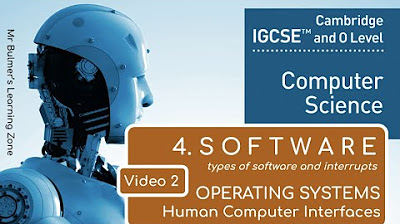39. OCR GCSE (J277) 1.5 Operating systems 1
Summary
TLDRThis video script delves into the technical features of operating systems, focusing on multitasking, memory management, and device drivers. It explains how multitasking creates the illusion of simultaneous program execution by rapidly allocating processor time. The script also covers how operating systems manage memory, including the concept of memory fragmentation and the use of virtual memory. Lastly, it discusses the role of device drivers in translating system instructions into hardware-specific commands, ensuring compatibility across different devices.
Takeaways
- 🖥️ Multitasking allows multiple programs to run seemingly simultaneously by rapidly allocating processor time to each.
- 🕒 The processor's quick task-switching creates an illusion of concurrent execution, though technically they're not running at the exact same time.
- 📚 Memory management is crucial for operating systems to allocate RAM to programs, handle program closures, and deal with memory fragmentation.
- 🔄 When a program is closed, its memory is marked as free, but not actually erased, which can lead to memory fragmentation over time.
- 📊 The operating system must efficiently manage and track memory fragments to optimize performance and avoid slowdowns.
- 🖨️ Device drivers are essential for translating generic operating system commands into hardware-specific instructions for peripherals like printers.
- 🖨️ Different printers require different technologies (inkjet, laser, plotter), hence the need for device drivers to standardize the printing process.
- 🔄 Virtual memory comes into play when physical memory is full, allowing the system to use disk space to extend RAM capabilities.
- 🔄 The operating system facilitates user interactions with various devices like keyboard, mouse, and screen, ensuring compatibility and functionality.
- 🔄 The script highlights the importance of the operating system in managing system resources, enhancing user experience, and maintaining system efficiency.
Q & A
What is multitasking in the context of operating systems?
-Multitasking is the ability of an operating system to run multiple programs simultaneously by allocating a small amount of time to each process, making it appear as if they are executing at the same time.
How does the processor create the illusion of multitasking?
-The processor rapidly switches between tasks, allocating a small time slice to each process, which happens so quickly that it feels like they are running simultaneously.
What are some examples of applications that might be running concurrently on a computer?
-Examples include a word processor with an open document, a web browser for research, a media player for music, antivirus software for security, and the clock for timekeeping.
What role does memory management play in multitasking?
-Memory management is crucial for multitasking as it involves loading programs into RAM, managing the allocation of memory spaces, and dealing with memory fragmentation.
How does the operating system handle the closing of a program?
-When a program is closed, the operating system marks the memory locations it occupied as free and available for reuse, although the actual data might not be erased immediately.
What is memory fragmentation and how does the operating system manage it?
-Memory fragmentation occurs when memory is divided into many small blocks due to programs being loaded and closed. The operating system manages these fragments to optimize memory usage.
Why are device drivers necessary for different types of printers?
-Device drivers are necessary because they translate the operating system's generic print instructions into specific commands that a particular printer model's hardware can understand, accounting for the differences in printing technologies.
What is the purpose of a device driver in an operating system?
-A device driver serves to convert the operating system's instructions into commands that a specific piece of hardware can execute, ensuring compatibility and functionality.
How does the operating system handle the loading of multiple programs into memory?
-The operating system decides where each program is held in memory. As programs are loaded and closed, the memory can become fragmented, and the OS must manage this to optimize performance.
What is virtual memory and when does the operating system use it?
-Virtual memory is a memory management technique used when the physical memory (RAM) is full. The operating system moves some data from RAM to disk storage to free up space in the RAM.
How does the operating system facilitate interaction with various hardware devices?
-The operating system uses device drivers to interface with different hardware devices, ensuring that the system's instructions are translated into commands that each device can interpret and execute.
Outlines

This section is available to paid users only. Please upgrade to access this part.
Upgrade NowMindmap

This section is available to paid users only. Please upgrade to access this part.
Upgrade NowKeywords

This section is available to paid users only. Please upgrade to access this part.
Upgrade NowHighlights

This section is available to paid users only. Please upgrade to access this part.
Upgrade NowTranscripts

This section is available to paid users only. Please upgrade to access this part.
Upgrade NowBrowse More Related Video

47. CAMBRIDGE IGCSE (0478-0984) 4.1 Operating systems - Part 1

43. EDEXCEL GCSE (1CP2) Operating systems - Part 1

13. OCR A Level (H046-H446) SLR4 - 1.2 Need for operating systems

20 Basic Operating System Interview Questions & Answers - Freshers & Experienced - Tech Interviews

BTEC Level 3 IT - P05 - Operating Systems (OS) - Types of Operating Systems

IGCSE Computer Science 2023-25 - SOFTWARE: Video 2 - THE OPERATING SYSTEM
5.0 / 5 (0 votes)